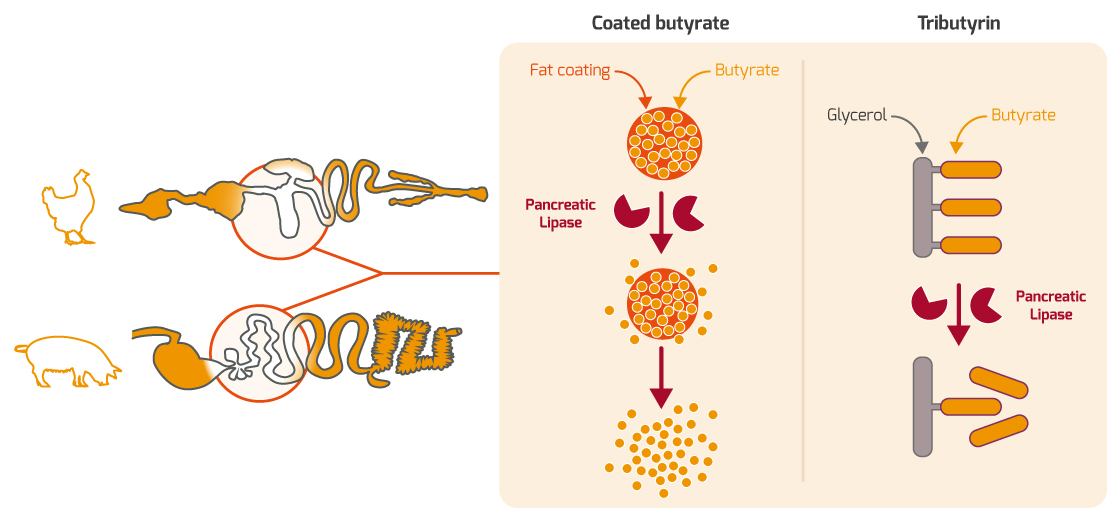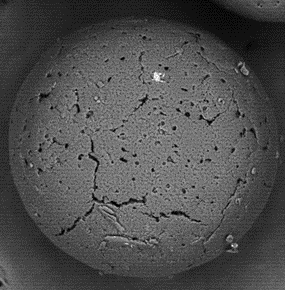



To profit from butyrate supplementation, the molecule needs to be at the right place and in the right quantity. In this second article of three, we explain why precision delivery is so important to maximise butyrate efficacy.
When butyrate is added to the diet, it triggers several beneficial effects in the digestive tract of animals (as described in our first article). There are different forms on the market, based on distinct production processes. In animal feed, butyrate salts or butyrins are used.
As butyrate can trigger different mechanisms throughout the entire digestive tract, it is of paramount importance to study how this molecule can be delivered in specific intestinal segments, and what the consequences of different release profiles are.
It is indeed essential that butyrate is released along the intestinal tract for it to express its full potential. However, butyrate is a small molecule that is easily absorbed and metabolised in the first part of the digestive tract, the stomach. This not only reduces the bioavailability of the product further in the gut, but can also induce an inflammation and/or a dysbiotic response in some cases.
Two main approaches have been developed to tackle the challenge of enteric butyrate delivery: the use of butyrate derivatives such as butyrins and the coating of butyrate.
In the case of butyrins, the lipase, secreted from the pancreas into the first part of the intestine, will cleave the bonds on the outside of the glycerol molecule, resulting in a target release response, mainly in the first part of the small intestine (Figure 1).
Butyrate salts are often further processed with encapsulation techniques such as spray-cooling/chilling, to give embed the molecule in a protective matrix.
The coating of most commercial butyrate salts is in the form of a protective fat matrix – usually hydrogenated palm oil. This fat-coating makes sure that most of the butyrate salt content will only be released once the lipase will break down the fat.

The value of butyrate products is determined by its capacity to delivery butyrate critical gut regions, rather than its butyrate concentration. However, we found that the coatings of different commercial butyrate products vary greatly in quality, which has a profound effect on their release characteristics. New techniques are available to better assess the quality of the coating (see box below).
An experiment showed that while fat coated butyrate products might look the same on paper, they can differ when you zoom in. Differences can be caused by the raw material used and/or production settings (e.g., speed of mixing) employed.
At the experimental facilities of Capsulae (France), two different prototypes of butyrate salts with the same composition (30% sodium butyrate embedded in a 70% hydrogenated palm fat-based protective matrix) were analysed using electron microscopy (EM) imaging and in vitro digestion assays.
This experiment showed that, when zooming in on the molecule after incubation in acid (to mimic the digestion process), the two prototypes showed:
These differences are hard to spot with the human eye, but are crucial for quality of the end product, product performance and customer satisfaction.

Adimix® Precision is a precision delivery coated butyrate salt, developed by Adisseo. The functional superiority and differences in protective characteristics of Adimix® Precision, compared to other coated butyrate products are the result of the following:
Adimix® Precision is embedded in a special coating, applied using spray-cooling techniques. As pioneers in butyrate coating, Adisseo products have benefitted from a long initial optimisation process.
The coating protocol was adjusted based on the characteristics of the sodium butyrate produced in Adisseo’s factory, resulting in functional superiority and differences in protective features compared with other coated butyrate products on the market.
The variety in capacity between different products is measured by Adisseo using the Target Release Capacity (TRC). The TRC is the amount of butyrate that still can be detected in the product after in vitro incubation mimicking gastric conditions. As such, the TRC is an estimate of the relative amount of butyrate that is protected from gastric absorption and that has the capacity to be target-released in the intestinal tract.
A product with a high TRC can trigger more beneficial gut health effects in animals, compared to products with a low TRC. In comparative evaluations, the TRC values of Adimix® Precision were higher than most chemically similar fat-coated butyrate products.
Adimix® Precision has been shown to be very stable during feed processing, with butyrate recovery values higher than 95% after pelleting, both at moderate and high temperatures. The product’s recovery was at least 84% following both extrusion and expansion.
This superior stability enables Adimix® Precision to act in all parts of the gut, even after feed processing. Trials in broilers showed a higher butyrate concentration in the caecal contents with the Adimix® Precision supplemented in pelleted feed, compared to unprotected butyrate and tributyrin.
Different commercial butyrate products liberate butyrate in different parts of the digestive tract. This has an important impact on their functionality. In the case of butyrate, it is essential that butyrate is released in regions in the digestive tract where it can be most most effective, for it to express its full potential. And this is exactly what Adimix® Precision does. In the next article we delve into more trials that confirm the efficacy of Adimix® Precision.
